The 3D format war rumbles on as LG wins latest round in the Australian court

You know those sci-fi movies where battling monsters rampage across the planet, flitting from continent to continent as they fight and leaving a trails of destruction in their path?
Well, that's what seems to be happening in the ongoing 3D 'format war' between Korean giants LG and Samsung, which has just played out its latest round in – of all places – an Australian court.
It all started with an advertising war in the Korean press, and a dispute over whether you could watch 3D TV while lying down, then the suggestion from a senior Samsung exec calling into question the intelligence of LG's engineers.
The latest round concerns a series of ads LG has been running on the TV down under: four of them, in fact, comparing aspects of its passive Film Patterned Retarder 3D technology with conventional active-shutter 3D tech.
In the ads, a man in a white coat used a split screen to demonstrate the superiority of passive 3D over active, covering brightness, flicker, the weight of the glasses involved and the need to change or recharge batteries in active 3D systems.
At which point, Samsung decided to get all legal on LG, feeling that – as it's the market leader in 3D – it was clearly the target of the ads: after consulting with the mothership back in Korea, it demanded that LG cease and desist from running the commercials forthwith, while it decided whether further legal redress would be sought.
The commercials, Samsung said, were deceptive and misleading, putting them in breach of the Australian Consumer Act. It challenged the ads' suggestions that lower brightness from active sets meant you'd have to watch them in the dark; that viewers using active glasses would need time to recover from discomfort or side effects from their use; and that active glasses needed frequent recharging, which would interrupt viewing.
Get the What Hi-Fi? Newsletter
The latest hi-fi, home cinema and tech news, reviews, buying advice and deals, direct to your inbox.
Interestingly, the flicker subject wasn't raised: LG had already withdrawn that ad after consulting with its legal advisers.
Judge Steven Rares, of the Federal Court of Australia, having seen a demonstration of the brightness of the two types of screen in court, viewed the other commercials, and heard extensive arguments from the Samsung legal team, decided not to allow Samsung's claim that the ads be suspended.
His view? Basically that viewers of the ads would be smart enough not to take them at face value, and would go to a shop and get a demonstration of the two technologies before making a buying decision.
Or as he put it, "In a practical sense, the likelihood of damage flowing from any misleading or deceptive impression that might initially have been conveyed by the brightness advertisement, that one had to view the conventional 3D televisions in the dark, is remote. Any such impression would be dispelled at the point of sale."
It looks likely that the legal wrangles will grind on, but it seems that for the consumer the best advice is to go and get a demonstration and decide for yourself.
Now where have I heard that one before?

Follow whathifi.com on Twitter
Andrew has written about audio and video products for the past 20+ years, and been a consumer journalist for more than 30 years, starting his career on camera magazines. Andrew has contributed to titles including What Hi-Fi?, Gramophone, Jazzwise and Hi-Fi Critic, Hi-Fi News & Record Review and Hi-Fi Choice. I’ve also written for a number of non-specialist and overseas magazines.
